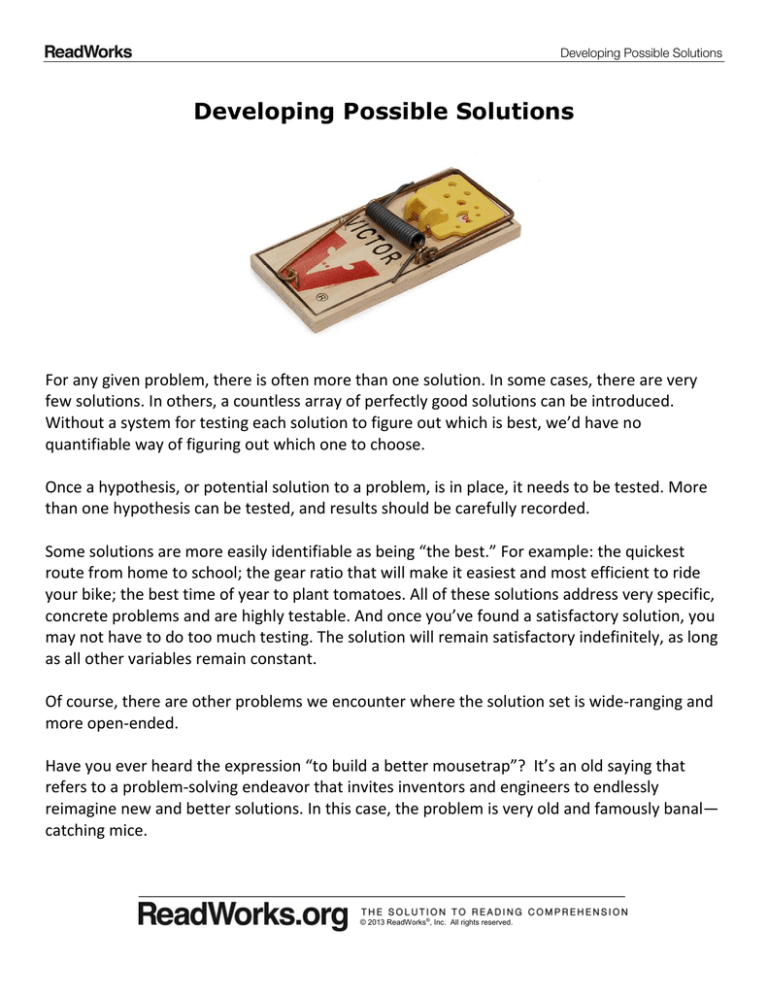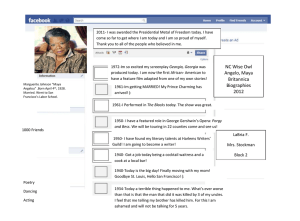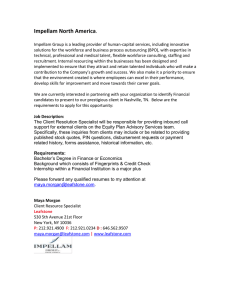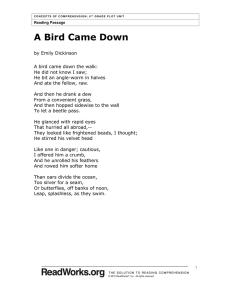Developing Possible Solutions
advertisement

Developing Possible Solutions Developing Possible Solutions For any given problem, there is often more than one solution. In some cases, there are very few solutions. In others, a countless array of perfectly good solutions can be introduced. Without a system for testing each solution to figure out which is best, we’d have no quantifiable way of figuring out which one to choose. Once a hypothesis, or potential solution to a problem, is in place, it needs to be tested. More than one hypothesis can be tested, and results should be carefully recorded. Some solutions are more easily identifiable as being “the best.” For example: the quickest route from home to school; the gear ratio that will make it easiest and most efficient to ride your bike; the best time of year to plant tomatoes. All of these solutions address very specific, concrete problems and are highly testable. And once you’ve found a satisfactory solution, you may not have to do too much testing. The solution will remain satisfactory indefinitely, as long as all other variables remain constant. Of course, there are other problems we encounter where the solution set is wide‐ranging and more open‐ended. Have you ever heard the expression “to build a better mousetrap”? It’s an old saying that refers to a problem‐solving endeavor that invites inventors and engineers to endlessly reimagine new and better solutions. In this case, the problem is very old and famously banal— catching mice. © 2013 ReadWorks®, Inc. All rights reserved. Developing Possible Solutions Most mousetraps might look like the ones we see in a hardware store. But a new, improved design is always possible. It might be something completely different. Like an electrical current rigged with mouse‐charming, atonal music; a gummy surface, following the principles of flypaper, designed to trap mice humanely; or, more organically, a housecat (with no bell). In this case, depending on the goals and constraints of the project, an unending number of different solutions are possible. Scientists use many different techniques and resources to develop solutions—these include induction, ideas from other fields and research, their own creativity, mathematical calculations, and whatever else they may have access to. The inspiration for new and elegant solutions can come from an unexpected place. Just as artists look to the world around them for creative stimulation, scientists often take cues from the environment. Although some people believe that artists and scientists do very different work, the two groups really have a great deal in common when it comes to problem solving and creativity. The “stages of inquiry” a scientist goes through to come up with a satisfactory or plausible solution is sometimes romanticized in the annals of history. Throughout history, scientists have reported sensations of ideation that read thrillingly. Archimedes, for example, leapt out of his bathtub in a fit of inspiration. Eureka! (This means “I have found it!” in Ancient Greek.) Lightning may not strike every time, and most researchers learn not to rest on their laurels with that expectation. Still, many people who spend lots of time pondering difficult problems are familiar with the tickling sensation of a hunch or the satisfying power of a breakthrough. After a solution or a set of testable solutions have been developed, the next step is to test them rigorously and systematically so that no aspect goes unexamined. In a controlled experiment, different groups of testable material are subjected to testing and compared with a control group for which outcomes are known. Experiments are usually regarded with a measure of skepticism themselves and are subject to change and redesign as the testing stage continues. If the solution follows its predicted behavior—for instance, if the flypaper mousetrap in fact traps the mouse humanely, as desired—then it’s a success. Funding is sought out for mass production of the flypaper mousetraps and investors start getting dollar signs in their eyes. But maybe the flypaper mousetrap is faulty. Perhaps the mouse overpowers the adhesive on the trap and escapes easily. Or maybe the chemicals in the adhesive poison the trapped mice, © 2013 ReadWorks®, Inc. All rights reserved. Developing Possible Solutions nulling the mousetrap as a humane pest control option. There are always a number of things that can go wrong. Once researchers observe problems with the proposed solution, they must go back and tweak the solution based on observed issues. In the case of our flypaper mousetrap, they’d have to look to the chemists who formulated the toxic adhesive. If one of the crucial goals of the mousetrap project was to leave caught mice unharmed, the process must prioritize that constraint. Once a new, non‐toxic adhesive has been developed, the product will go back into testing. This process will be repeated until all of the conditions and constraints of the project have been satisfied. This order of operations can go on for a long time. Some commercial products have appeared to meet all criteria in the lab, and once released to the general public, have failed, sometimes with dangerous results. Testing commercial products for commercial distribution is just one example of how the scientific method is applied carefully and comprehensively to make sure that solutions are as safe and successful as possible on the other end. This stage and all stages of the scientific method are what we call iterative, meaning they are subject to repetition with the goal of achieving a desired goal or result. Scientists will test a solution over and over again, altering it each time until the results satisfy every criterion. Failures can be discouraging, but they can also be instructive and useful! Certain kinds of failure may lead to reevaluation of the project’s original intent and even redefinition of the elements. For example, if our mousetrap flypaper continues to fail—no matter how many times it is altered—there is something fundamentally incompatible with mice and tacky paper. Each constituent part would have to be investigated more deeply, and new conclusions drawn from that second cycle of research would be used to inform a new design. This can lead to amazing new discoveries. Often a testing scenario will be conducted by a group of scientists, even generations of testers, as individuals pass in and out of the experiment. It can be helpful to introduce a new individual’s perspective to the research—it’s a creative collaboration that benefits from many minds at work, rather than just one. A classical model of scientific inquiry was established a long time ago by Aristotle, who broke down reasoning into three categories: abductive, deductive and inductive inference. The distinctions between these three modes of problem solving have to do with how leaps in logic © 2013 ReadWorks®, Inc. All rights reserved. Developing Possible Solutions are made from one set of information to the next. Abduction has been defined as guessing, meaning it involves making certain assumptions that are only based on known results and not yet proven. Abduction relies more heavily on creative projection than deductive or inductive inference. Inductive inference relies upon a degree of anecdotal support from past testing. Scientists take into account specific examples of how materials or organisms are known to behave and apply that information to make predictions about how situations involving similar materials or organisms will play out. Inductive reasoning is regarded as probable, meaning that it is not foolproof. It is only more likely. Deductive reasoning is the inverse. Broad principles, rather than specific examples, are applied to specific materials, organisms or situations, and results are predicted based on those ideas. All of these strategies are called into play in a testing scenario. As more information is pulled, testing scenarios can change and evolve. There is no satisfying a truly rigorous team of scientists. In designing solutions that meet every project constraint and push research to instructive new territory, it’s necessary to keep asking questions and keep redesigning experimentation, even after a seemingly satisfactory solution has been achieved. This may seem like a frustrating burden to bear, but the results have led humankind to amazing progress. Patience with the testing process is ultimately rewarded not just with advanced, reliable solutions to everyday problems, but with new information that can be applied and reapplied to other scenarios as well. © 2013 ReadWorks®, Inc. All rights reserved. Questions: Developing Possible Solutions Name: _____________ Date: _______________________ 1. What is used to determine whether a potential solution to a problem will actually work? A B C D creative stimulation lucky guesses old sayings and tickling sensations a test or series of tests 2. What sequence of actions is described in this passage? A B C D the the the the steps steps steps steps taken taken taken taken to to to to write a science textbook play atonal music solve a problem interview a scientist 3. Read this sentence: “For any given problem, there is often more than one solution.” What evidence from the passage supports this statement? A Catching mice can be done by using electricity, a sticky surface, or a cat. B Abductive reasoning involves making assumptions based on results that have not been proven. C Artists and scientist have a lot in common, though many people do not realize it. D The word “eureka” means “I have found it” in Ancient Greek. 4. What is one way that testing helps scientists determine which solution for a problem works best? A Testing allows scientists to thinking about it. B Testing allows scientists to and deductive reasoning. C Testing allows scientists to each other. D Testing allows scientists to importance of solving it. choose a solution without having to spend time rely on abductive reasoning rather than inductive compare the effectiveness of different solutions with ignore the seriousness of a problem and the 1 © 2013 ReadWorks®, Inc. All rights reserved. Questions: Developing Possible Solutions 5. What is this passage mainly about? A B C D the discoveries of Archimedes determining the best time of year to plant tomatoes flypaper mousetraps solving problems 6. Read the following sentence: “For any given problem, there is often more than one solution.” What does the word solution mean? A B C D disaster scientist answer artist 7. Choose the answer that best completes the sentence below. One problem may have many possible solutions, _______ it is important to perform tests in order to choose a solution. A B C D as an illustration so instead before 8. What are the three categories of scientific reasoning described by Aristotle? ______________________________________________________________________ ______________________________________________________________________ ______________________________________________________________________ ______________________________________________________________________ 2 © 2013 ReadWorks®, Inc. All rights reserved. Questions: Developing Possible Solutions 9. What is deductive reasoning? ______________________________________________________________________ ______________________________________________________________________ ______________________________________________________________________ ______________________________________________________________________ 10. Explain how one of the three types of reasoning identified by Aristotle could be used in developing solutions. ______________________________________________________________________ ______________________________________________________________________ ______________________________________________________________________ ______________________________________________________________________ 3 © 2013 ReadWorks®, Inc. All rights reserved. The Age of Exploration By ReadWorks For thousands of years, people have been fascinated with world exploration and discovering new places and cultures. Historically, one of the most efficient ways to navigate the world was traveling by sea. From the ancient Greeks to medieval Spanish kings, exploration was a major goal for governments because it offered the prospect of new commercial operations and trade routes. For example, Spanish ships could sail to China and bring back Chinese spices and silks (which were unavailable on mainland Europe) to sell to Spanish markets. Early explorers relied on a navigational system called “dead reckoning,” or calculating their position based on previous positions (like landmasses) and their estimated velocity and drift to make sure they did not veer off course; however, this method was an inexact science. As exploration became more important for Europe’s economic interests, advanced devices that made exploration easier and more exact were developed. © 2014 ReadWorks®, Inc. All rights reserved. The “age of exploration” marked a new frontier for sea navigation. This epoch began in the 15th century when Portugal and Spain started to expand their commercial interests and trade routes across the oceans, resulting in the exchange of goods and sometimes even traditions. Sailors used new technologies to navigate across the world, including a device called the quadrant, a fan-shaped magnetic object that measured the altitude of stars, the moon, and the sun in order to determine the latitude of a ship. Another device was the compass, which used Earth’s magnetic poles to point navigators north, south, east, or west. Time-keeping devices, like hourglasses, were important in calculating how far and how fast a ship had sailed. Early navigators also used maps, although these were not always accurate and were often written during the course of the exploration. These maps were then improved upon with new explorations. It was an exciting time to be an explorer. Governments would pay men to navigate ships across the open seas and discover new lands. One of the most famous explorers was Christopher Columbus, the Italian navigator who set out to find a more efficient route to India and instead stumbled upon what is now known as Central America and South America. At the time of his sailing, Columbus only had a few navigational instruments available to him, including the compass, an astrolabe (a device that predicted the location of stars and helped explorers determine their latitudinal or vertical position on a globe), a quadrant, and incomplete maps. Columbus’s incomplete knowledge of world geography and the imprecise navigational devices he brought with him caused him to inadvertently discover the Americas and all the rich natural resources available there. You can imagine the difficulties explorers had with the available technologies during Columbus’s time when you think about Columbus’s experience. He meant to travel from Spain to India, which we now know would have required him to sail first west, then south, then north. Instead, Columbus traveled west and believed he had reached the farthest place from Spain, © 2014 ReadWorks®, Inc. All rights reserved. the complete opposite side of the world: India. On the one hand, the tools’ inaccuracies made exploration by sea inconsistent and unpredictable; on the other, explorers at the time had limited knowledge of the world’s geography, which also hindered exploration of unknown territory. These issues, along with the financial risks involved, made it difficult for some governments and kings to agree to fund explorations during which their navigators could become irretrievably lost. As time went on, more European countries began to explore the world. In the late 17th century, Great Britain joined the navigational tool race, developing modern tools such as the sextant and the chronometer, which replaced tools used by the earliest explorers. The sextant was used to measure the angles between the horizon and celestial objects in order to determine the ship’s latitude. Longitude was nearly impossible to calculate until the invention of the chronometer, an accurate timekeeping device. These modern inventions arrived after much of the world had already been explored, but allowed ship captains to cut down the length of time they were at sea, and improved accuracy in route planning. © 2014 ReadWorks®, Inc. All rights reserved. Name: Date: _______________________ 1. According to the passage, what was historically one of the most efficient ways to navigate the world? A B C D traveling traveling traveling traveling on by by by foot sea horse air 2. The passage lists different navigational instruments available to explorers. Which of the following navigational instruments was not available to Christopher Columbus? A B C D the the the the sextant astrolabe compass quadrant 3. Limited knowledge of world geography was a problem for early exploration. What evidence from the passage supports this conclusion? A B C D Navigational maps were improved with each new exploration. Columbus set out to find a more efficient trade route to India. Columbus unintentionally sailed to the Americas. The compass used Earth’s magnetic poles to direct navigators. 4. How did navigational tools change from the 15th century to the 17th century? A B C D They They They They became became became became larger. smaller. less accurate. more accurate. 5. What is this passage mostly about? A B C D Christopher Columbus’s discovery of the Americas the tools and challenges of exploration by sea travel tools made by the United Kingdom in the 17th century why governments were hesitant to fund explorations 1 © 2014 ReadWorks®, Inc. All rights reserved. 6. Read the following sentence: “Columbus’s incomplete knowledge of world geography and the imprecise navigational devices he brought with him caused him to inadvertently discover North America and all the rich natural resources available there.” As used in this sentence, what does “inadvertently” mean? A B C D happily purposefully accidentally fortunately 7. Choose the answer that best completes the sentence below. Early navigational techniques such as “dead reckoning” were imprecise; ________, exploring uncharted seas was challenging and inconsistent. A B C D consequently otherwise ultimately especially 8. Why was exploration a major goal for governments? ______________________________________________________________________ ______________________________________________________________________ ______________________________________________________________________ ______________________________________________________________________ 2 © 2014 ReadWorks®, Inc. All rights reserved. 9. Why did some governments and kings have difficulty agreeing to fund explorations? ______________________________________________________________________ ______________________________________________________________________ ______________________________________________________________________ ______________________________________________________________________ 10. The text states that “as time went on, more European countries began to explore the world.” Use information from the text to explain why more European countries began to explore the world as time went on. ______________________________________________________________________ ______________________________________________________________________ ______________________________________________________________________ ______________________________________________________________________ 3 © 2014 ReadWorks®, Inc. All rights reserved. A Mix of Colors and Cultures A Mix of Colors and Cultures By ReadWorks Boom-cha boom boom-cha boom. Maya bopped her head to the salsa music that played in the distance. She looked toward the beat’s source—off to her left, a group of Spanishspeaking students were practicing a dance for the culture festival that their school was holding later in the day. The dancing girls wore swinging, vibrant skirts that swayed as they wiggled their hips to the horns and drums of the music. Maya wished that she could dance like that. In front of her, parents were setting up food stations along the main corridor of the international school. As the mothers and fathers lined up the traditional food items of their native countries on little tables, they wiped off the beads of sweat that had accumulated on their foreheads. April is the hottest month in Bangkok, Thailand, and they were all feeling it. Maya headed inside to the dance studio to get dressed, but mostly to feel the icy breeze of the air conditioner. Doooom chik-chik dooooom chik-chik. As she approached the school’s dance studio, Maya began to hear cymbals clashing, a sound increasing in volume—dance practice must have already begun. “Maya! How nice of you to join us,” Mrs. Apasiri greeted her student as she walked through the doorway. “Grab your candles and join in, please,” the teacher instructed. Maya wove through the seven girls who were swaying on the dance floor to the other side of the room where her costume was. She fumbled through her bag for the two candles she would need. After finding them, Maya rushed out onto the floor. They were performing the “Fawn Tian,” or candle dance, a traditional Thai folk dance. “Four on the right and four on the left, please,” Mrs. Apasiri told her dancers, arranging their formation. “The orchestra will be behind you, so just remember that when you start moving around,” she added. The girls were to perform last in the entire show, so that their candles could flicker in the dark of the night. Mrs. Apasiri turned on the music, a combination of string and percussion instruments. Maya listened to the humming notes of the saw duang, a two-stringed instrument typically used in classical Thai music. She, along with the other dancers, slowly moved up and downstage as they gracefully swung their hands right and left, being cautious so as to not extinguish the candle flames. Once they finished practicing, it was time to get dressed. A few mothers of the dancers had wandered in during the rehearsal and were waiting patiently to start helping out with makeup and hair. Maya walked over to her bag and pulled out a full-length silk sarong, a jacket, and a matching scarf to wear over one shoulder. She hurriedly wrapped the blue and green sarong around her waist, thinking about the swaying salsa skirts as she looked down at © 2015 ReadWorks®, Inc. All rights reserved. A Mix of Colors and Cultures the straight, starched lines of her own. A mother ushered her over to the hair station, sat her down, and proceeded to squirt an excessive amount of gel into her hands. “Hurry along, girls!” Mrs. Apasiri chimed in, glancing down at her watch. “Twenty minutes until the show starts!” Once Maya’s hair was slicked back in a tight bun, she placed a gold headdress on. It looked like an elegant crown, speckled with red and green gemstones, coming to a long, pointed tip at the top of her bun. After everyone put the finishing touches on their costumes, they left the studio to settle in backstage until their performance. Dooop do-do-do dooop. Maya pulled back the heavy black curtain just slightly to peek out at the traditional Korean dancers on stage. They donned big, billowing red skirts that ballooned out as they spun around in circles to the strings that accompanied their movements. She admired the large fans the dancers waved and shook for the audience. Next up was the salsa performance. Even the members of the audience began shaking their hips to the contagious beat and clapped their hands to the sound of the drums. Maya watched as if she had never seen their dance before, mesmerized by the way the boys led their partners, as if they were connected by invisible strings. Mrs. Apasiri soon broke Maya’s focus. “Get ready, girls!” she instructed her dancers. The salsa music began to fall quiet, and Maya lined up with the other girls. As they walked onto the stage, the audience oooed and ahhhed at the candles flickering in the girls’ hands. They performed their dance to a smiling crowd. Upon their finish, Maya felt a tinge of pride—she glanced at the other dancers on stage as the music faded, lingering on the silk skirts reflecting the light of the candles. Looking at her own, she felt the same admiration she had felt for the other groups. Once all of the dancers had changed out of their costumes, the food vendors opened. Parents dished out their hard work in plastic bowls, ready to volunteer any information about the food they had prepared. Maya wanted to try all of it. She and her friends set down the main corridor of the school. Jen wanted Korean food, Divesh wanted German, Chris wanted Thai. As they each presented their arguments, Maya snuck away. She collected a variety of dishes from various booths and grabbed a large plate. She returned to her friends, who hadn’t noticed her disappear. She placed the plate in front of them and proceeded to dump all of the food onto the white plastic. “What are you doing, Maya?!” Divesh asked impatiently. “Come on, just try it,” she told her friends. They each grabbed a fork and reluctantly tried Maya’s mixture. Slowly, they all began to nod their heads in approval. “Nice work, Maya,” Chris said with a mouth full of food. She smiled in response. © 2015 ReadWorks®, Inc. All rights reserved. Questions: A Mix of Colors and Cultures Questions: A Mix of Colors and Cultures Questions: A Mix of Colors and Cultures



